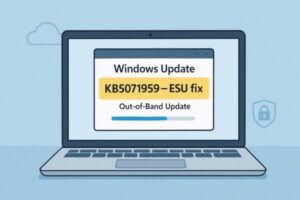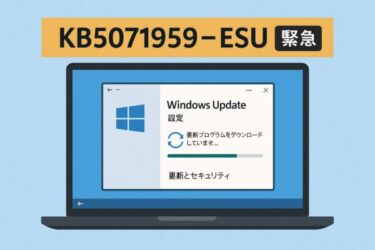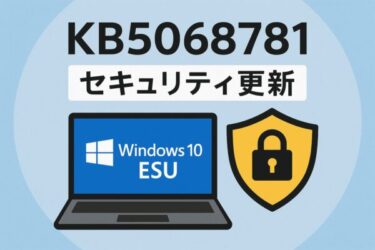
- 1 Introduction — why KB5071959 matters
- 2 What this Out-of-Band update fixes
- 3 Who should install it (and who can skip it)
- 4 How to install KB5071959 (two safe methods)
- 5 How to confirm the fix
- 6 Troubleshooting if installation or enrollment still fails
- 7 Frequently asked questions (quick answers)
- 8 Step-by-step recap (copy-paste checklist)
- 9 Optional: “What changed today?” (press & refs)
- 10 Conclusion
Introduction — why KB5071959 matters
On November 11, 2025, Microsoft shipped KB5071959 as an Out-of-Band (OOB) update for Windows 10 version 22H2 (OS build 19045.6466). This emergency patch addresses a bug that stopped some users from completing ESU (Extended Security Updates) enrollment—the program that lets Windows 10 continue receiving security updates after end of support. If enrollment failed with vague errors like “Something went wrong,” this update is for you.
Industry outlets and Microsoft’s own notes confirm the fix and outline the exact flow: install KB5071959, reboot, run the ESU enrollment wizard, and then check for updates again.
TL;DR: If you plan to keep Windows 10 for a while, install KB5071959 first—then enroll in ESU and fetch the November security updates.
What this Out-of-Band update fixes
Microsoft’s support page states that KB5071959 is an Out-of-Band release whose goal is to unblock ESU enrollment for affected Windows 10 22H2 devices. After installing the update and restarting, the Windows 10 Consumer ESU enrollment wizard should complete successfully, enabling future ESU updates to arrive via Windows Update.
Independent reporting (BleepingComputer, How-To Geek, Neowin, etc.) matches this guidance and reiterates the same four-step flow to get back on track.
Who should install it (and who can skip it)
Install KB5071959 now if:
- You are on Windows 10 version 22H2 and intend to remain there for the time being.
- Your device couldn’t complete ESU enrollment or showed confusing “out of support” messages in Settings.
- You want to immediately resume receiving security updates after October 14, 2025. Microsoft Learn
You can skip (for now) if:
- You’ve migrated to Windows 11 and no longer run Windows 10.
- You do not plan to enroll in ESU at all (note the security risk of staying unpatched).
How to install KB5071959 (two safe methods)
Method A — Windows Update (recommended)
- Open Settings → Update & Security → Windows Update and choose Check for updates.
- When “Cumulative Update for Windows 10 Version 22H2 (KB5071959)” appears, install it.
- Restart your PC to complete installation.
- Launch the Windows 10 Consumer ESU enrollment wizard and complete enrollment.
- Return to Windows Update and Check for updates again to pull the latest ESU patches (e.g., November rollup).
Method B — Microsoft Update Catalog (if A doesn’t show it)
If Windows Update doesn’t surface the patch due to caching or rollout timing, download and install KB5071959 manually from Microsoft’s Update history / Catalog. Verify the OS build reads 19045.6466 afterward (winver).
How to confirm the fix
- Press Win + R, type
winver, and confirm OS Build 19045.6466 or later. - Open Settings → Windows Update and confirm “Check for updates” works and new ESU updates download normally.
- If you previously saw “You’re out of support” banners, they should be gone following Microsoft’s fix and/or enrollment completion.
Troubleshooting if installation or enrollment still fails
1) Windows Update doesn’t offer KB5071959
- Clear update cache (stop Windows Update service, delete
SoftwareDistribution, restart service) and retry; or install manually via the Catalog/update history links.
2) ESU enrollment wizard still errors out
- Confirm KB5071959 is installed and the device rebooted.
- Try enrollment again from Settings → Windows Update → Enroll now (wording may vary by locale).
- Ensure the device is Windows 10 22H2 (ESU for other editions or channels may differ).
3) “Out of support” message persists
- Microsoft acknowledged a message bug and said a fix is rolling out; a reboot and reconnection to the internet may help. If it continues, apply the latest fixes and retry later.
4) You installed KB5071959 but can’t get the November ESU rollup
- After enrollment completes, return to Windows Update and Check for updates again; the November cumulative should then download. (This sequence is explicitly noted in multiple reports.)
What exactly is ESU—and how long does it last?
ESU is a paid (or otherwise licensed) extension that delivers security updates beyond Windows 10’s public end of support on October 14, 2025. Consumer ESU enables an additional year of security updates via Windows Update once a device is properly enrolled.
Security posture: ESU vs. upgrading to Windows 11
ESU is a bridge, not a destination. If your hardware supports Windows 11, upgrading reduces risk and simplifies patching. If you must remain on Windows 10 for now, KB5071959 + ESU enrollment restores your monthly security update pipeline. Balance costs, app compatibility, and device lifecycle in your planning.
Frequently asked questions (quick answers)
Q1. Is KB5071959 a normal Patch Tuesday update?
A. No—it’s Out-of-Band, released outside the usual cadence to quickly fix the ESU enrollment issue.
Q2. What build should I see after installing it?
A. 19045.6466 (Windows 10 version 22H2).
Q3. Do I need to run the ESU wizard after installing?
A. Yes. Install KB5071959 → reboot → run the Consumer ESU enrollment wizard → check for updates again. BleepingComputer
Q4. I don’t plan to join ESU. Should I still install KB5071959?
A. If Windows Update offers it, installing won’t hurt, but ESU is the mechanism that provides security updates going forward. Without ESU (or moving to Windows 11), you’ll increasingly miss critical patches. Microsoft Learn
Q5. Where can I see official reference pages?
A. Microsoft’s KB5071959 article and Windows 10 update history page list the update and its OOB nature.
Step-by-step recap (copy-paste checklist)
- Settings → Windows Update → Check for updates
- Install KB5071959 (OOB) → Restart
- Open the ESU enrollment wizard and finish enrollment
- Return to Windows Update → Check for updates again to grab the monthly rollup
- Confirm build 19045.6466 with
winverand keep regular backups going forward
Optional: “What changed today?” (press & refs)
- Microsoft’s official KB page confirms the OOB update and ESU enrollment steps.
- Update history lists KB5071959 for 22H2 and points to current cumulative updates.
- Multiple outlets (BleepingComputer, How-To Geek, TechRadar, Neowin) reported the fix and the exact 4-step flow.
Conclusion
KB5071959 is the small but crucial first domino: install it, enroll in ESU, and your Windows 10 security updates should flow again. If you’re able to move to Windows 11, start planning the transition; if you must remain on Windows 10 for business or hardware reasons, ESU + a solid backup routine keeps you safe in the meantime.
Related Articles
・Windows 10 ESU: Why the “Enroll now” Link Isn’t Showing (and How to Fix It)


